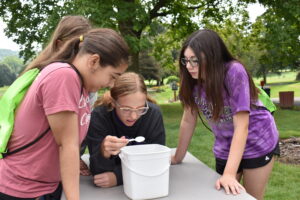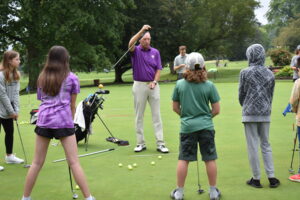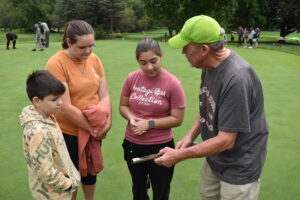
Maci Phillips grimaces when she looks at the contents of pond water. With her are Isabella Montalvo, left, and Alana Jervis.
Bella Montalvo uses a plastic spoon to scoop pond water from a bucket.
The water, drawn from a pond at Yankee Run Golf Course in Brookfield, is not appetizing – greenish-yellow with a lot of specks. If you look closely, it’s clear there are hundreds of insects and other floating, darting, rolling or swimming creatures in the bucket. Bella, a Brookfield Middle School seventh-grader, raises the spoon to show a black spot about the size of a pinpoint.
“If I remember correctly from yesterday, that’s a water mite,” Bella said.
Bella and about 10 other students participated in Brookfield Middle School’s science, technology, engineering and math camp, which included a field trip to Mosquito Creek the day before they visited Yankee Run. Kari Filipovich and Megan Rodgers taught the week-long class.
The largest creature in the bucket was a squirming, caterpillar-type thing.
“There’s a good chance that’s a dragonfly larva,” Bella said.
The visit to Yankee Run on Aug. 10 was part of a program called First Green offered by the Golf Course Superintendents Association of America. It promotes golf courses as ecology labs and the game itself, said Shane Conroy, field staff representative for the Great Lakes Region of GCSAA.
“Golf courses are life-learning labs,” said Conroy, who came from Detroit to participate. Golf course managers are concerned about soil and water quality, vegetation and wildlife, and using as few chemicals as possible, he said. They practice “environmental stewardship,” he said.
“Golf courses are a community asset and a community benefit,” Conroy said.
Golf course co-owner Garret McMullin said few people realize the amount of science that goes into golf course management.
“There’s a lot of chemistry,” he said. “There’s a lot of studying. There’s a lot of new things that pop up.”

Bob Collins holds his putter like a pendulum to show middle school students how they should swing their arms when putting.
Yankee Run Club Pro Bob Collins, who also is a Professional Golf Association pro, introduced the students to golf by giving them tips on putting – stance, swing, body positioning, follow through – and ran them through several putting stations.
“I hope you all take up golf,” Collins said. “As you can see, it’s a lot of fun. This is just a first step.”
Then, golf course owners Garret and Gary McMullin and Conroy showed the students how to use golf course management tools. Gary McMullin used a soil probe to take a sample down to about six inches of the practice putting green. The sample showed sand, which Gary said is applied to greens after they have been aerated, the root structure of grass, and thatch, which is grass clippings and other organic material, which affects water absorption.
Because the grass on greens is cut so low, “It almost has to be a perfect environment,” with proper amounts of sun and rain, Gary said.

Gabe Garcia, Isabella Muffly and Isabella Montalvo examine a soil sample taken by Gary McMullen, co-owner of Yankee Run Golf Course.
Garret McMullin used a stimpmeter, a piece of metal about two feet long, to determine how fast a green is. The stimpmeter is placed on the ground and one end is lifted until a golf ball rolls off. The students measured how far the ball traveled.
Conroy gave the students soil thermometers. Soil temperature is used to determine when to plant grass and treat lawns, whether it be applying fertilizer, pesticides or herbicides, he said.
The McMullins also showed the different kinds of mowers they use and discussed hole placement and maintenance.
“I thought it was fun that we got to learn how many days they have to treat the golf course and how really hard it is, and about learning about all the mowers and what they do,” said Brodie DeMaria, an 11-year-old sixth-grader.
The best part of the camp was getting outside, “instead of being stuck inside all day,” Brodie said.
Lily Horsman, a 12-year-old seventh-grader, said she enjoyed the STEM camp.
“I just like doing fun things,” she said. “Summer was kind of boring. I wanted something to do.”
Garret McMullin said he liked how the First Green program mixes a fun activity – golf – with more academic concerns. He said he would like to host more student groups.
“I think it’s a great learning process,” he said. “Obviously, trying to find the fun things in some of the things can be a little bit more difficult. It’s a little bit more serious than what they may think, but, you gotta start somewhere.”







